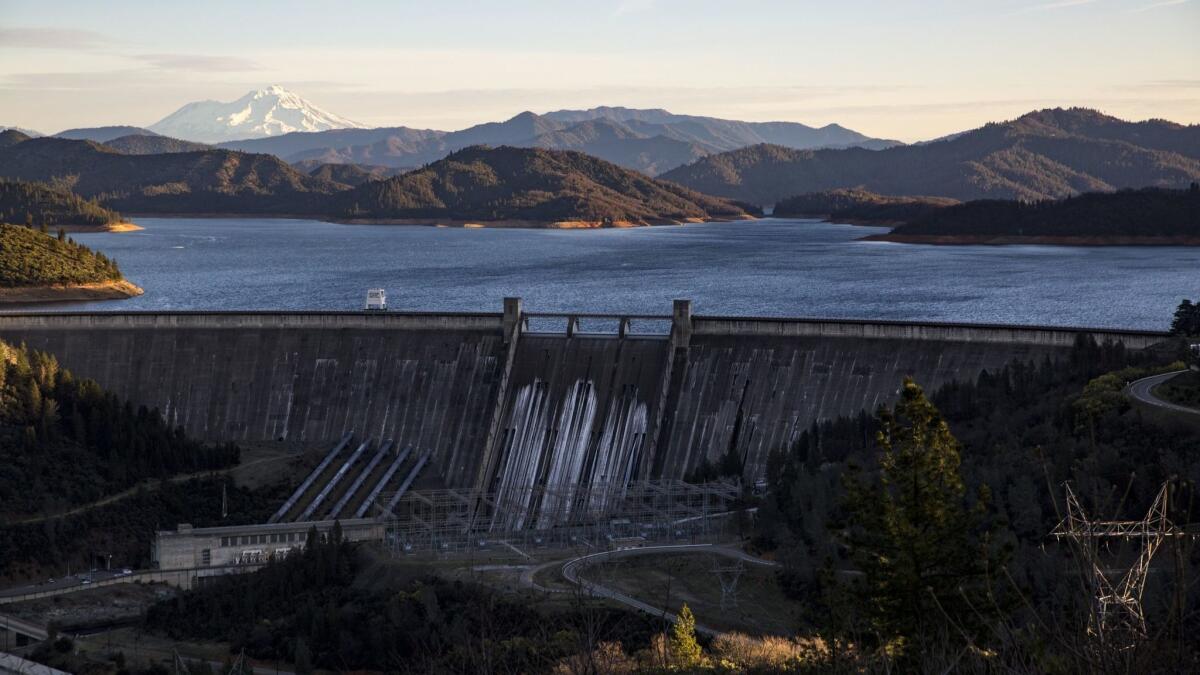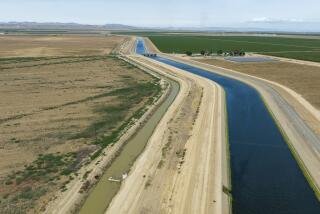Tiny salamander in Northern California could spell big problem for plans to heighten the Shasta Dam

- Share via
A trio of tiny salamander species could mean big trouble for federal officials spearheading a controversial $1.4-billion public works project to heighten the Shasta Dam in Northern California.
Two environmental organizations — the Center for Biological Diversity and the Environmental Protection Information Center — filed a federal lawsuit last month asking a judge to force the U.S. Fish and Wildlife Service to determine whether the Shasta salamanders should be protected under the Endangered Species Act.
The Center for Biological Diversity asked the wildlife service in 2012 to declare the amphibians either endangered or threatened, but the agency never made a decision, said Jenny Loda, an attorney for the environmental group.
Under federal law, U.S. Fish and Wildlife was required to make a determination on the salamanders within a year. After six years passed with no ruling, the center decided to sue.
The move was prompted, in part, by the federal government’s sudden momentum in efforts to raise the Shasta Dam nearly two stories, a project that environmentalists say would destroy the salamanders’ habitat and put them at risk of extinction.
“Salamanders were historically harmed by the original creation of the dam,” Loda said. “The dam turned a pretty small lake into a very large lake and flooded their habitat. They can’t survive in the water like that.”
The battle to raise the dam’s height has been waged for decades. The current fight underscores simmering tensions between the state and federal government and highlights the momentum with the current administration.
Central Valley farmers are eager for the extra water it could mean for their crops, noting their growing operations are among the first to face restrictions during periods of drought or when water is redirected to save threatened and endangered species.
In 2015, the U.S. Bureau of Reclamation completed a federal environmental analysis of raising the dam but shelved the project at the time because the bureau wanted local and state agencies to help shore up the cost.
When Donald Trump was elected president, the project was injected with new life. Westlands Water District, which provides water to more than 1,000 square miles of farms in Fresno and Kings counties, offered to help fund it.
“Westlands was on a mission from God to finish this project,” said Ron Stork, a senior policy analyst with Friends of the River. “The Trump administration has let Reclamation staff and leaders express their inner reclamation after being repressed for so many years — ‘We can go out there and build some dams and who cares if it’s illegal.’ ”
The California Wild and Scenic Rivers Act, passed in 1972, prohibits the 602-foot structure from getting any taller. But in an era of tension between Washington and California, the state’s objection to the project isn’t proving to be a deterrent for the Trump administration, which is moving forward with the plan.
Among the animals touted in the state’s long-running fight over water are the Delta smelt, which live in San Francisco Bay and the Sacramento-San Joaquin Delta and have been protected by the Endangered Species Act since 1993.
Farmers for years have blamed the tiny freshwater fish for destroying their crops and putting them out of business. The lowly smelt even found itself in Trump’s cross-hairs during the presidential campaign when he repeated the claim that the government was taking farmers’ water supply and “shoving it out to sea … to protect a certain kind of 3-inch fish.”
The smelt’s population has been falling for decades as huge volumes of freshwater are diverted through aqueducts and canals, allowing brackish water to infiltrate deeper into the delta and placing more stress on the tiny fish. Environmentalists, who contend that the Delta smelt is near extinction, have said that the species is considered the bellwether of the health of the delta ecosystem and that its dwindling numbers are an alarming signal for the state’s water crisis.
Balancing water projects meant to serve farms and growing urban populations while protecting species that are impacted by the changes has become a recurring scenario in California, and a point of debate.
One of the more straightforward reasons is because untangling the state’s issues surrounding water is challenging. Centering the conversation around a species is easier for people to wrap their minds around, said Travis Longcore, an urban ecologist and assistant professor at USC.
“There’s a lot of moving parts around this, and it gets boiled down to endangered species versus water — and doesn’t everybody need water?” Longcore said. “It’s sometimes inappropriate to hang one agenda on the back of a species, but that’s where the debate has been happening.”
It’s also rooted in numbers. California is home to a large population of animals protected by the government, so the likelihood that one might be affected by an infrastructure project is greater.
“A lot of species end up being found in California and nowhere else,” Longcore said. “The state is a biodiversity hot spot.”
Federal officials contend that increasing the height of the New Deal-era Shasta Dam — the largest reservoir in California — is necessary and would allow it to store even more water and improve reliability for agricultural and other uses.
The situation with the Shasta Dam became more urgent for environmentalists in March when Congress approved $20 million to jump-start the heightening project. The Bureau of Reclamation, the division of the Interior Department overseeing the plan, expects to award initial construction contracts in early December 2019.
The U.S. Fish and Wildlife Service declined to comment on the lawsuit.
Other environmentalists and fishing industry groups also have rallied against a bigger Shasta Dam. Those groups have said federal findings that some wildlife could benefit from the project are undermined by government scientific studies showing it would create serious problems, particularly for salmon. The Golden Gate Salmon Assn. is among the groups that have opposed the project.
The plan also is staunchly opposed by the Winnemem Wintu Tribe, which already suffered the destruction of its homes and ancient burial sites when the dam was completed in the 1940s. Tribe officials have said raising the dam would inundate much of their remaining sacred ground.
Despite all of the other opposition, it could be a 4-inch lungless amphibian that’s found only in Shasta County that ultimately throws a wrench in the works.
The Shasta salamander was considered one species until April when scientists split it into three species — the Shasta salamander, the Samwel Shasta salamander and the Wintu Shasta salamander — based on DNA analysis. It’s unclear how many of the animals are in the area because there hasn’t been research done to estimate their population, Loda said.
If the wildlife service determines the salamanders are threatened with extinction, Loda said, the federal agency would have to assess the direct impacts raising the dam would have on the amphibians and help initiate a plan to raise the dam without harming the animals. But that task might not be so simple, according to Loda.
“It’s just a bad idea overall,” Loda said of the project. “We don’t think the benefit of having a little more water storage outweigh the risks. It’s hard to see how they could do the project without having some impact.”
“Their syllogism just isn’t coming true anymore,” said Stork of the Friends of the River. “So, they keep pounding at the door and persuading people to fund feasibility studies and now we have the Trump administration, … somebody that believes making America great again, and that comes with starting up a great new dam building era.”
Twitter: @Hannahnfry
More to Read
Sign up for Essential California
The most important California stories and recommendations in your inbox every morning.
You may occasionally receive promotional content from the Los Angeles Times.










